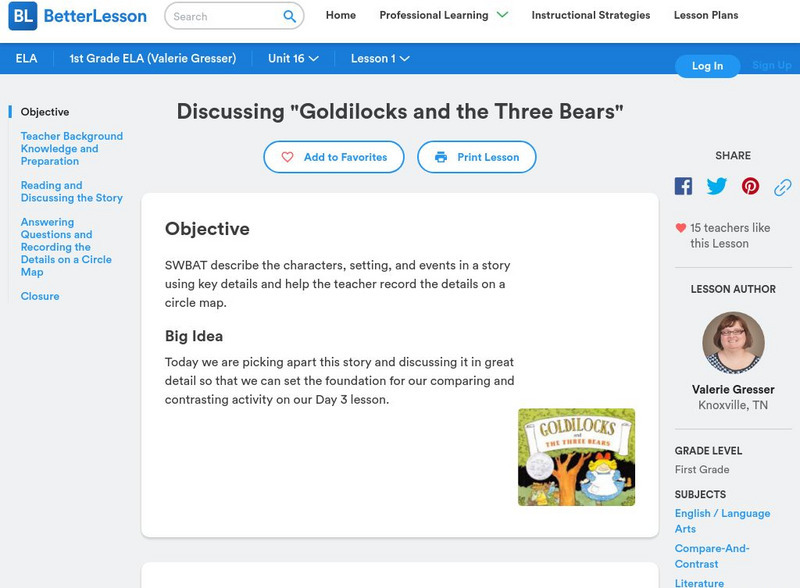ReadWriteThink
Read Write Think: Charting Characters for a More Complete Understanding
Contains plans for one 60-minute lesson that teaches about a reading strategy called Character Perspective Charting. In addition to student objectives and standards, these instructional plans contains links to PDF handouts and links to...
ReadWriteThink
Read Write Think: Defining and Exploring an Author's Stylistic Choices
Contains plans for two lessons that teach students how to recognize an author's use of style in literature. These plans use "Their Eyes Were Watching God" by Zora Neale Hurston as an example, but the basic ideas can be adapted to other...
ReadWriteThink
Read Write Think: Avoiding Sexist Language by Using Gender Fair Pronouns
Contains plans for two lessons that teach learners how to avoid gender stereotyping while using pronouns. In addition to objectives and standards, this instructional plan contains links to sites used in the lessons as well as assessment...
ReadWriteThink
Read Write Think: Comparing and Contrasting: Picturing an Organizational Pattern
Contains plans for two 50-minute lessons that teach about the comparison/contrast organizational pattern. In addition to objectives and standards, this instructional plan contains links to PDF handouts and sites used in the lessons as...
ReadWriteThink
Read Write Think: Choosing Clear and Varied Dialogue Tags: A Minilesson
Contains plans for one 50-minute lesson that teaches about using dialogue tags like "he said" or "she answered." In addition to student objectives and standards, these instructional plans contain links to PDF handouts and links to sites...
Other
Critical Reading: Three Ways to Read and Discuss Texts
Designed to help students think about their reading and writing skills, this page offers three different ways to interpret and discuss texts.
ReadWriteThink
Read Write Think: Using Word Webs to Teach Synonyms for Commonly Used Words
Contains plans for seven lessons that teach students to use more expressive synonyms in their written and oral language. In addition to objectives and standards, this instructional plan contains printable resources for the lessons as...
ReadWriteThink
Read Write Think: Figurative Language Awards Ceremony
Contains plans for five to seven lessons that teach about figurative language like similes, metaphors, and personification by asking students to write award acceptance speeches that incorporate them. In addition to objectives and...
ReadWriteThink
Read Write Think: Teaching Point of View With Two Bad Ants
Contains plans for two lessons that teach point of view using the book "Two Bad Ants" by Chris Van Allsburg and titles from the from the "Look Once, Look Again" series by David M. Schwartz. In addition to objectives and standards, this...
ReadWriteThink
Read Write Think: Research Building Blocks: Notes, Quotes, and Fact Fragments
Contains plans for a lesson on taking notes that is part of a larger unit on researching a state symbol. It works on skills like figuring out what information is relevant and irrelevant, using a variety of sources, and paraphrasing. In...
ReadWriteThink
Read Write Think: Character Clash: A Mini Lesson on Paragraphing and Dialogue
Contains plans for a minilesson that teaches about proper dialogue format while writing, specifically paragraphing. In addition to objectives and standards, this instructional plan contains links to sites used in the lessons as well as...
ReadWriteThink
Read Write Think: Finding Figurative Language in the Phantom Tollbooth
Contains plans for four lessons that use The Phantom Tollbooth by Norton Juster to teach about figurative language. In addition to objectives and standards, this instructional plan contains links to handouts and to sites used in the...
ReadWriteThink
Read Write Think: Developing, Writing, and Evaluating Persuasive Speeches
Contains plans for four lessons that teach learners how to make and present strong persuasive speeches. In addition to objectives and standards, this instructional plan contains links to sites used in the lessons as well as assessment...
AdLit
Ad lit.org: Classroom Strategies: Monitoring/clarifying
The Monitoring/Clarifying strategy teaches students to recognize when they don't understand parts of a text and to take necessary steps to restore meaning. This technique is a component of the Reciprocal Teaching model in which teachers...
Learning Farm
Learning Farm: Explaining Relationships
An interactive activity that practices determining relationships between events and concepts.
Wisconsin Response to Intervention Center
Wisconsin Rt I Center: Writing to Learn [Pdf]
Teachers will learn how to use Writing to Learn as a formative assessment tool. Teachers will learn how to implement the strategy, measure progress, and find research to support writing to learn. A list of Writing to Learn activities is...
Better Lesson
Better Lesson: Discussing "Goldilocks and the Three Bears"
Today we are picking apart this story and discussing it in great detail so that we can set the foundation for our comparing and contrasting activity on our Day 3 lesson.
Wisc-Online
Wisc Online: How to Listen Better
Students read a description of what it means to listen respectively. Then they write a brief action plan for becoming a better listener.















![Wisconsin Rt I Center: Writing to Learn [Pdf] Professional Doc Wisconsin Rt I Center: Writing to Learn [Pdf] Professional Doc](https://static.lp.lexp.cloud/images/attachment_defaults/resource/large/FPO-knovation.png)

